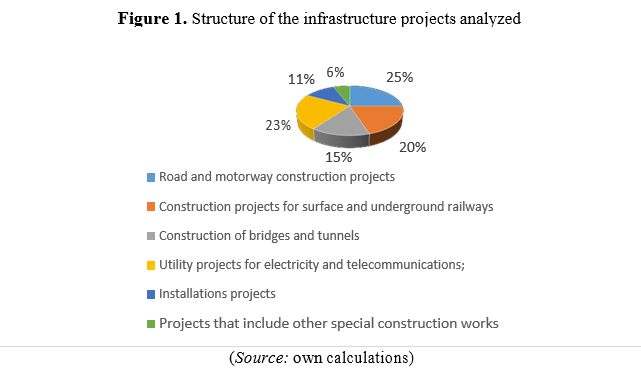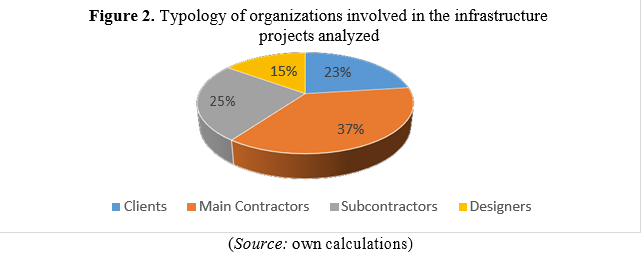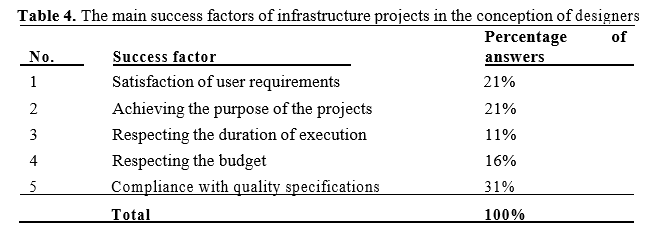How can infrastructure projects be measured for success?

Abstract
The article includes an analysis of how stakeholders involved in infrastructure projects in Romania perceive the main success factors. Starting from the most important approaches of the success factors of the infrastructure projects in the literature, a series of typologically representative infrastructure projects were selected and their stakeholders were questioned about the most important success factors in infrastructure projects implementation. There are differences of vision among the stakeholders involved in the success factors of the projector, but everyone believes that the most important success factors are compliance with execution time, budget, and quality specifications.
JEL Classification: M10, M19
Table of content
1. Introduction
2. Literature Review
3. Aims of the research
4. Research Methodology
5. Findings
6. Conclusions
1. Introduction
One of the most important problems of infrastructure projects in Romania is the appreciation of their success by the public and by the parties involved. Issues that arise during their lifecycle are numerous and the appreciation of their success by the parties involved differs. Achieving successful infrastructure projects is a matter of interest for Romania’s future economic and social development, as it is conditional on the development of economic sectors such as transport and the automotive industry.
Infrastructure development is also essential to attract foreign investment. Access to a modern infrastructure and connection to the European one is some of the most important issues raised by companies that already have major investments in Romania and those who would like to open new production capacities on the local market.
Examples of companies in the automotive industry (Renault and Ford) who have repeatedly complained about the absence of promised investments in road infrastructure are known to create additional problems in the supply of raw materials and in the sale of the produced output.
That is why it is important to study the factors and criteria used to assess the success of infrastructure projects by the parties involved in the implementation of these projects. By knowing these factors, a series of actions can be taken in the design and implementation of projects in the future, leading to the successful completion of public infrastructure projects.
Through the research carried out within this article, we intend to quantify the main success factors in the realization of public infrastructure projects, but also the differences of vision existing between the various actors (clients, project managers, project team members) involved in their realization, because not all those involved in the realization of the infrastructure projects have the same vision of the success of a project. Client organizations, for example, will be more interested in the project exploitation period compared to organizations involved in project execution.
2. Literature Review
In the literature, the criteria and factors for assessing the success of projects are not defined in a unitary way but on the contrary, there are a number of different approaches that are used for this purpose. Turner (1993) considered time, cost and specifications to be the most important success factors in project execution. He thus shared Kerzner’s (2013) vision that time, cost and quality were the main criteria for evaluating the success of projects.
Turner himself admitted that these factors mainly represent the vision of the contractors involved in the projects and less the vision of the clients. Later, Turner considered that the criteria that can be used to assess the success of the projects are: achievement of the project goal; providing a satisfactory benefit to the project owner; meeting the needs of the project owner, project users and project stakeholders; the achievement of the project objectives; producing facilities and deliverables as specified; meeting the expectations of the project team.
On the other hand, Kerzner completes the traditional approach (time, cost, quality) through three additional criteria for assessing the success of the projects: changes to the purpose of the project are to be agreed by the parties involved in the project; the implementation of the project does not lead to substantial changes in the workflows of the organizations involved in the implementation of the projects; the implementation of the project does not bring important changes in the culture of the organization. The last two criteria are, in our opinion, debatable because projects are innovative and unique, which can lead to changes in existing workflows within an organization and even organizational culture. However, the culture of the organization is not a static character but is an ensemble of constantly changing elements. Cultural practices are viewed as dynamic, ongoing, everyday actions that produce social reality (Feldman and Orlikowski, 2011).
Morris and Hough (1987) considered that a project is successful if it: delivers the main functional elements; is implemented according to budget, deadlines and technical specifications: it is profitable for the company involved in its execution. The same specialists considered that a project could be considered as a successful project even if it was not finished if its premature closure was done reasonably.
Wateridge (1998) conducted a research on the success of IT projects using as a success criterion: satisfying user requirements, accomplishing the purpose of projects, observing execution time, budget and quality. The same author also pointed out that the criteria for assessing the success of a project differ in the case of timely and failed projects. Wateridge also showed that there are differences of vision regarding the success of a project among the actors involved in its conception, implementation and exploitation. Most specialists believe that the relationships between the parties involved in the realization of a project, especially those between clients and contractors, are essential to its success (Bryde and Robinson, 2005, Toor and Ogunlana, 2008).
Chan et al., (2004) classified the factors that affect the success of projects in five main categories: project-specific factors, project procedures, project management, human resource factors, external factors. These factors are in interdependence relations, their manifestation as a whole affecting the success of projects.
Cooke-Davies (2002) pointed out that there is a difference between project success and the success of project management. In order to measure the success of a project, it is necessary to complete it. Evaluating the success of a project management involves an assessment of the life cycle of the project (Han et al., 2012).
KPMG in the study entitled “Success and failure in urban transport infrastructure projects” considered that the success of infrastructure projects has three important dimensions: financial success, policy success, durability success. In the same study, KPMG took into account six factors that condition the success of projects: project environment and turbulence, political control and sponsorship, role of national government, planning, efficiency of procurement and financing, organizing operations.
3. Aims of the research
As a result of the study of the literature through the research carried out within this article, we propose the following objectives:
• establishing the main factors that determine the success of the infrastructure projects in Romania;
• highlighting the differences of vision among the stakeholders regarding the factors that condition the success of the infrastructure projects in Romania;
• establishing success factors at different stages in the lifecycle of infrastructure projects in Romania;
• In establishing these objectives, we have considered the main results obtained so far by the researches carried out in different countries and the fact that in Romania, although the subject is one that is in constant public debate, there were no researches to define and measure success in the field of projects infrastructure.
4. Research Methodology
The proposed research methodology was developed on the basis of the study of the specialized literature and the previous results obtained. The proposed research methodology includes the following steps and methods of carrying out the research:
1. Establishing the typology of infrastructure projects carried out in Romania in the last 10 years on the basis of the information published by the National Statistics Institute and those requested from ministries, public institutions and companies that have carried out infrastructure projects.
2. Selection of a representative number of projects where the study of success factors is triggered. The selection was made typologically, not statistically, so that each type of infrastructure project realized in Romania in the last 10 years was represented in the sample of analyzed projects. 50 projects have been selected in the following areas:
• road and motorway construction projects;
• construction projects for surface and underground railways;
• construction of bridges and tunnels;
• utility projects for electricity and telecommunications;
• installations projects;
• projects that include other special construction works.
3. Elaboration of the standard list of successful factors in the field of infrastructure projects based on the ones already elaborated in the specialized literature.
4. Making the questionnaire to be completed by the stakeholders involved in the infrastructure projects in Romania. In particular, customers, designers, main contractors and subcontractors, end-users were targeted. The questionnaire covered the following categories of questions:
• a category of questions that reveals the particularities of the organization to which the respondent belongs: the form of involvement in the project (client, contractor, subcontractor, designer, end-user of the infrastructure); type of organization (public or private); the organization's annual budget; the number of staff of the organization.
• a category of questions about the respondent: age, seniority in the organization, professional experience, experience in infrastructure projects;
• a category of questions about the nature of the infrastructure project: type of infrastructure project; project budget; the number of people forming the project team; stakeholders involved;
• a category of questions about the success factors in the infrastructure projects in which the respondents were involved. They were allowed to choose from a list of standardized factors, but they also had the opportunity to identify success factors that were not found in this list.
In the last category of questions, multiple answers were made, aiming at highlighting the most important success factors in the realization of the infrastructure projects in Romania.
5. Launching the questionnaire and receiving the answers from the respondents. Emails were sent to 250 respondents and answered 132 respondents, equivalent to a response rate of 52.80%.
6. Analysis of the answers and formulate the conclusions of the research regarding the most important success factors for the infrastructure projects carried out in Romania. In the response analysis process, it was found that 4% of the responses were incomplete, equivalent to a final response rate of 48.8%.
5. Findings
The main categories of projects represented in the selected sample are the road and motorway construction projects with 25% of the analyzed projects followed by utility projects for electricity and telecommunications (Figure 1). The least represented in the sample are the projects involving the execution of other special construction works with only 6% of all the analyzed projects.

From the point of view of the respondents’ typology (Figure 2), the majority of respondents belonged to the respondents from the main contractor’s organizations, with 7% of the total of the answers to the questionnaire, followed by subcontractors with 25% of the total answers, and of customers with 23% of all responses.
The least represented in the overall responses are the designers, but it should be taken into account that the number of staff in these organizations is much lower compared to the other stakeholders and that these organizations participating in the project are involved in a component that has the shortest duration in the cycle life.

From the answers to the questionnaire formulated by the clients, according to the data from Table 1, it can be noticed that the main success factors of the projects in the clients 'conception are the fulfillment of the purpose of the projects (with 34% of the opinions expressed), the satisfaction of the users' requirements (with 24% formulated) and respecting the execution time with 24% of the responses.

For customers, according to the structure of the answers in Table 1, compliance with the project budget and quality specifications seems to be much less important than the achievement of the project goal. An explanation for these results is that most infrastructure project clients are public organizations whose staff are not directly involved in pursuing quality compliance, but indirectly through a hired consultant to perform these checks.
The main success factors of the infrastructure projects in the main contractors’ view are presented in table no.2.

In the conception of the main contractors, the most important success factor of the infrastructure projects is the observance of the execution time with 30% of the answers. The fulfillment of the project goal and the observance of the quality specifications have almost the same importance for the respondents from the main contractors as the budget observance. Achieving the expected profits from engaging in projects replaces satisfying user requirements as a success factor for projects in the design of key contractors.

The main success factors of infrastructure projects, in the conception of subcontractors, are budget compliance, followed by compliance with the execution time. Obtaining the expected profit counts much more for subcontractors as a success factor for the projects in relation to the respondents’ views expressed by the main contractors.
Table 4 shows the main success factors for infrastructure projects in conception of designers.

In the conception of the designers, the main success factor of the projects is the observance of the quality specifications, followed by the satisfaction of the users requirements and the fulfillment of the purpose of the projects. Designers are less interested in respecting the duration of the project because they are not directly responsible in this regard.
6. Conclusions
Establishing the most important success factors for infrastructure projects is a very important issue for this type of project in Romania. These projects are conditional on the development of other economic sectors and, for this reason, the success of their achievement is important for all stakeholders.
In our research, we considered the most important success factors for infrastructure projects both as a whole and the differences in vision of the most important stakeholders involved in this respect. Respect for execution time, budget, and quality specifications are considered by all stakeholders as a success factor for infrastructure projects.
Among stakeholders involved in project implementation there are a number of differences in approaching project success. While for clients the most important success factors are the achievement of the purpose of the projects and the satisfaction of the user’s requirements, for the main contractors the most important factor of the successful infrastructure projects is the observance of the execution time. Designers believe that the main success factor of projects is compliance with quality specifications and that subcontractors attach greater importance to respecting the budget.
The project’s success factors, highlighted in this paper, seem to indicate that there is a possibility to define and measure success in infrastructure projects. In most cases, those involved in the implementation of infrastructure projects in Romania have given the greatest importance in their responses, the most important success factors highlighted in the literature.
Contributo selezionato da Filodiritto tra quelli pubblicati nei Proceedings “International Conference on Economics and Social Sciences – Challanges and Trends in Economic and Social Sciences Research - 2018”
Per acquistare i Proceedings clicca qui:
http://www.filodirittoeditore.com/index.php?route=product/product&path=67&product_id=149
Contribution selected by Filodiritto among those published in the Proceedings “International Conference on Economics and Social Sciences – Challanges and Trends in Economic and Social Sciences Research - 2018”
To buy the Proceedings click here:
http://www.filodirittoeditore.com/index.php?route=product/product&path=67&product_id=149



